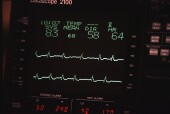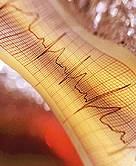| 
Infusion Therapy Raises Death Risk for Some Heart Patients
 TUESDAY, Nov. 27 (HealthDay News) -- An infusion of glucose, insulin and potassium, a treatment thought to help people right after they have had a heart attack, actually increases the immediate risk of heart failure and death for some patients, a new study shows.
Previous research has produced mixed results, with smaller studies supporting the use of GIK therapy, as the treatment is known, and one larger study showing no effect on the death risk 30 days after a heart attack.
However, patients with an ST-segment elevation myocardial infarction, a type of heart attack commonly known as STEMI that shows a particular electrical pattern, should not be given the infusion right away because that increased risk lingers for them in the first three days after diagnosis, the researchers said in a statement.
"GIK therapy increased levels of glucose, potassium, and net fluid gain post-infusion, all three of which predicted death after adjusting for multiple confounders. Adjusting for glucose, potassium, and net fluid gain eliminated the apparent increase in mortality at 3 days observed with GIK infusion, suggesting a direct association with these factors. Administration of GIK infusion within 4 hours of symptom onset yielded no benefit compared with later initiation," the authors wrote.
Their report is published in the Nov. 28 issue of the Journal of the American Medical Association.
The research team, which included scientists from Argentina and Emory University in Atlanta, analyzed data from two separate trials of almost 23,000 STEMI patients. Although the researchers found no difference in outcome at 30 days and six months, when they looked at the first few days following a heart attack, they discovered an increased risk of both heart failure and death in the patients who received the infusions. In the first three days, there were 1,509 incidents of heart failure or death (15.8 percent) in the infusion group, compared with 1,388 incidents of heart failure or death (14.5 percent) in the control group.
The researchers noted that this largest-ever analysis "demonstrates that GIK infusion has no effect on any important clinical endpoint through 30 days following STEMI. However, contrary to our pre-specified hypothesis, we observed a higher rate of death and the composite of death or heart failure at 3 days in patients allocated to GIK therapy compared with control."
More information
The American Heart Association has more on heart attack treatments  . .
|  |

Defibrillators Not Dangerous While Driving
 MONDAY, Nov. 26 (HealthDay News) -- The defibrillators that are implanted in people for instant correction of abnormal heartbeats pose no special risks for heart patients who drive, researchers report.
"What this confirms is what we already thought, that overall there is not a huge risk in this population," said study lead author Dr. Christine M. Albert, director for the Center for Arrhythmia Prevention at Brigham and Women's Hospital in Boston.
About 50,000 defibrillators are implanted annually in the United States. Among the famous recipients is Vice President Dick Cheney, who experienced an irregular heartbeat Monday and was being examined by his doctors.
There have been worries that the shock delivered by the device to correct an abnormal heartbeat might be dangerous for drivers, Albert said.
The study included 1,188 people with such a device, whose formal name is implantable cardioverter-defibrillator (ICD). The patients were followed for an average of 562 days, during which time the devices delivered a total of 193 shocks within one hour of driving -- a rate of one shock for every 25,116 person-hours driving. None of the shocks resulted in an accident.
Overall, the study found that the incidence of having an ICD shock was not higher while a participant was driving. One oddity in the findings was that an ICD shock was twice as likely to be delivered during the 30 minutes after someone drove a car, Albert said, an indication of possible strains caused by driving.
"These data provide reassurance that driving by ICD patients should not translate into an important rate of personal or public injury," the researchers wrote.
The findings are published in the Dec. 4 issue of the Journal of the American College of Cardiology.
"This is very strong evidence that our worries were not based on fact but were theoretical," said Dr. Bruce Wilkoff, director of cardiac and tachyarrhythmia devices at the Cleveland Clinic.
But common sense factors into the safety issue of ICDs and drivers, Wilkoff added. "People who have frequent shocks tend not to drive in the first place," he said. Twenty percent of the ICD recipients in the study did not drive at all, Wilkoff noted.
Current guidelines say that someone who is given an ICD after experiencing a major arrhythmia -- an irregular heartbeat -- should not drive for at least one week after the implant. The one-week restriction also applies for patients who have not experienced an arrhythmia to allow for recovery from the surgery. Driving restrictions then should be decided during consultation with a physician, Albert said.
In practice, that works out to "don't drive when you're not feeling well," Wilkoff said.
More information
Learn more about ICDs from the American Heart Association  . .
|  |

Urine Test Results Can Point to Heart Dangers
TUESDAY, Nov. 20 (HealthDay News) -- Even a small amount of a protein called albumin in the urine of patients with stable coronary artery disease increases their risk of cardiovascular death, say U.S. researchers.
The findings from this study of almost 3,000 patients, age 50 and older, with stable coronary artery disease (CAD) have implications for assessing and perhaps treating patients with vascular disease.
The study was published in the current issue of the journal Circulation.
Albumin is normal and necessary in blood, but its presence in urine indicates leakage in the kidney filtration system and possible damage to cells that line the kidney's blood vessels, according to background information in the study.
"We found that virtually any degree of albuminuria, even albumin below the level we call microalbuminuria, placed a patient at significantly higher risk of cardiovascular events," lead author Dr. Scott D. Solomon, associate professor of medicine at Harvard Medical School and director of Noninvasive Cardiology at Brigham and Women's Hospital in Boston, said in a prepared statement.
He and his colleagues also found that the hypertension drug trandolapril (an ACE inhibitor) lowered albumin levels in patients' urine.
The findings of this study and previous research by the same team indicate that "we cardiologists need to pay more attention to kidney function in our patients, and we need to look at two aspects -- filtration and albuminuria," Solomon said.
"It is important for cardiologists to understand that these are not patients who will even come to dialysis or even necessarily see a nephrologist," he said. "But they do have mild kidney disease that puts them at increased risk for a cardiovascular event."
More information
The U.S. National Institute of Diabetes and Digestive and Kidney Diseases has more about protein in urine.
|  |

Heart Death Rates Worsening for Middle-Aged Adults
 MONDAY, Nov. 19 (HealthDay News) -- The gains made against coronary death rates in recent decades are starting to slip away for middle-aged Americans, public health officials report.
Overall, the picture looks rosy, said a report that used U.S. vital statistics data between 1980 and 2002 for all people aged 35 and older. The death rate from coronary disease fell by 52 percent in men and 49 percent in women.
"In older age groups, the reduction is still going on," said lead researcher Dr. Earl S. Ford, a medical officer in the U.S. Public Health Service, who co-authored the report with Dr. Simon Capewell of the University of Liverpool in England.
But the picture is more bleak for Americans aged 35 to 54.
For men of that age, the average annual rate of death from coronary disease declined by 6.2 percent in the 1980s but only by 2.3 percent in the 1990s. It then dropped at an annual rate of 0.5 percent between 2000 and 2002.
For women between 35 and 54, the average annual death rate from coronary disease dropped by 5.4 percent in the 1980s but then slowed to 1.2 percent in the 1990s. Between 2000 and 2002, the annual death rate for women in this age group actually increased, by 1.5 percent annually.
"What we are seeing reflects experience among the youngest people we looked at," said Ford, whose team published its findings in the Nov. 27 issue of the Journal of the American College of Cardiology.
Things look better when all patients 35 and older are included. On an annual basis, the coronary disease death rate among men 35 and up declined by 2.9 percent a year during the 1980s, 2.6 percent a year during the 1990s and 4.4 percent a year from 2000 to 2002. For all women aged 35 and over, the annual coronary death rate declined by 2.6 percent, 2.4 percent and 4.4 percent annually for those periods, respectively.
Why are middle-aged adults faring more poorly?
"We can't tie these rates to anything in particular, so we have to speculate," Ford said. That speculation centers on well-known risk factors for coronary disease, such as obesity, diabetes, high blood pressure and lack of physical activity.
"There is a major epidemic of obesity in the United States," Ford said. "There have been no major decreases in smoking. [Changes in] cholesterol levels are also flat. Also, hypertension in the United States is something people have to pay more attention to."
There is a steady drumbeat of public warnings and doctors' advice about these risk factors, noted Dr. Philip Greenland, a professor of preventive medicine at the Northwestern University Feinberg School of Medicine, who wrote an accompanying editorial. But somehow the message still isn't getting through.
"People do know, and then again, they don't know," he said. "The information we've tried to get to patients is almost common knowledge. We're telling people what they already know. They've heard it a million times. Maybe they're waiting to hear something new."
The public may be getting a mixed message, Greenland added. "We've been telling people for years that we've conquered heart disease, that the mortality rates are going progressively down. But the risk factors exist, and to say that we've conquered the problem is a non sequitur."
The editorial was aimed at practicing physicians, Greenland said. "There is a tendency for physicians to ignore what is known about heart disease. I was trying to get across the idea that if we in the medical profession don't wake up, the gains we thought we achieved will be slipping away from us."
The increase in death rates has affected other areas of cardiovascular disease, said Dr. Martha Daviglus, a professor of medicine and preventive medicine at Northwestern University, Chicago, and a spokeswoman for the American Heart Association.
"For stroke, it is even worse," she said. "The decline in the last 10 years has been very bad."
The message on obesity and other factors of a healthy lifestyle are being ignored by younger Americans, Daviglus said.
"Young people think it's not going to happen to them," she said. "They're wrong."
More information
There's more on coronary risk factors at the American Heart Association  . .
|  |
|